Construction on the Monumental Building began in 1875. Sgt. William M. Van Fossen, color bearer for the
99th Ohio Volunteer Infantry Regiment, dedicated the cornerstone with these words: Done
in the memory of the fallen heroes of Shelby County, the state of Ohio and the town of
Sidney, June 24th, in the year of our Lord 1875.
The most sacred part of the edifice was, and is,
the tablet area originally located on the second floor and now on the first floor.
"Cut in polished marble and etched in gold, the names of 309 brave soldiers speak a
silent tribute to their ultimate sacrifices," Rich Wallace,president of the society noted. A tablet recently
erected by the Historical Society lists the names of 15 more heroes inadvertently left off
the original tablets.
The Monumental Building has special state-wide
significance.
- Shelby County was first in Ohio to come up with the idea of
a civic center to honor Civil War dead.
- Shelby County was the first in Ohio to erect such a
building, ahead of Dayton, Cleveland, and Cincinnati.
- Only 14 such buildings were erected in Ohio; 12 remain.
- The village of Sidney and Clinton Township teamed to sell
bonds to pay for the construction.
| Sixty thousand tickets were printed with a
ticket price of the tidy sum of one dollar each. Despite their best efforts, only 38,145
tickets were sold. The Thompson family won the lottery and claimed Carey's Hall. The net profit from the venture was
just $9,154, and Shelby County's effort to honor its soldiers had not gotten off to a very
good start. Four years of inactivity then followed.
Within three weeks after the Ohio
General Assembly passed an act in May, 1871, that provided for the appointment of trustees
and the raising of moneys to build monuments to honor the soldiers of the "War of the
Rebellion," local attorney Willis P. Stowell presented a petition of the Shelby
County Common Pleas Court, resulting in the appointment of the first trustees.
The idea for the creation of a building, rather than a monument, to honor the soldiers
was discussed generally in town, but the details were first raised in an anonymous Sidney
Journal ‘Letter to the Editor’, printed in its June 17, 1870, edition. The
author commented:
"The only question then, it seems to me, should be, what kind of structure will
best answer the purpose. While we desire to commemorate the dead and honor the living
soldier, ought we not to consult common prudence as to the best method of effecting this
object? The useful as well as the ornamental ought to be studied. A building would meet
this condition better than a marble shaft."
The author went on to suggest most of the basic ideas, including the concept of a
cultural center, that were later incorporated in the structure. After much public debate,
it was decided to purchase the lot that was the site of the Ackerly Tavern, and before
that, the old Farmer's Hotel. |
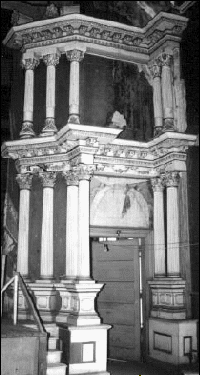
The north side of the stage
on the third floor, as it appeared in 1998.
|
The Monumental Building as it appeared prior to the installation of
"Sgt. Baker" in 1900.
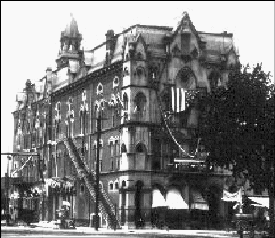
By 1873, the property had been acquired. The building was eventually torn down to make
way for the Monumental Building. Clinton Township and Sidney work together to raise money.
Fund raising then, as now, was the major problem. With interest, the trustees had only
$11,000. Nearly half of that amount was allocated to the purchase of the lot, and the
estimate for the construction of the edifice was $65,000. It was felt the citizens of
Sidney alone could not pay this amount. Fortunately, the right community leaders stepped
forward and in the fall of 1874, the idea was proposed that the residents of Clinton
Township and Sidney join together in the effort to complete the memorial. The issue was
put to the voters. In the first instance of such regional cooperation, the Village of
Sidney and Clinton Township residents decided to raise the needed funds by selling bonds
as equal partners in the venture. The Shelby County Democrat reported that the vote was
"nearly unanimous." When the first installment of bonds proved insufficient, the
residents approved more money the following year.
On behalf of the veterans, a building committee composed of Col. Harrison Wilson, along
with representatives from Sidney and Clinton Township, was formed. Designs submitted by
Cleveland architect, Samuel Lane, were approved and his compensation set at $1,248 (about
2% of the total cost). Later, he was also granted a $200 performance bonus.
Eight long years had passed from the time the first funds were raised until the
cornerstone was laid on June 24, 1875. Sgt. W.M. Van Fossen, color bearer for the
99th Ohio Volunteer Regiment, and veteran Californian 'Forty Niner,' dedicated the
cornerstone of the building with these words: "Done in the memory of the fallen
heroes of Shelby County, the state of Ohio and the town of Sidney, June 24th, in the year
of our Lord 1875."
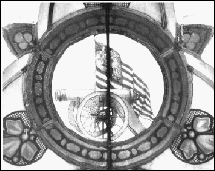 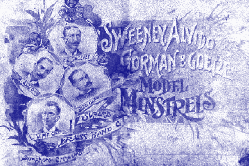
On the left, a stained
glass window commemorating the Civil War/military can be found on the southeast corner of
the Monumental Building second floor. At right, a visiting theatre troupe left their label on
one of the pillars of the stage on the third floor.
Work proceeded steadily throughout the next nine months.
Production delays and cost overruns were apparently as much of a problem then as now.
Idled by a lack of stone for the building, the stone masons stopped work in the winter of
1876. The Sidney Journal related on February 25 that these men "entertained
the idea of celebrating the centennial year and handing down their names to
posterity." They inscribed their names on the top of Big Rock in what is now
Tawawa Park. Their names, along with the national emblem, and the year, 1876, are still
clearly visible in the stone face. The rock is located a short distance past Tawawa Lake
(heading into the park) on the right. A sign marks the location.
Other problems arose. The Democrat reported in March of 1876 that all available
funds had been used up, and the building was not finished. The editor of the paper posed
the query as follows: "The question now is shall it be finished by the
appropriation of the necessary amount for its completion, or, shall it stop in its present
situation to become a laughing stock and a disgrace to town and township."
The trustees made the decision to borrow the needed funds, and the Monumental Building was
finished on April 11, 1876. The trustees were $8,711 in debt, but were the proud owners of
the first memorial hall constructed in Ohio to honor the Civil War soldiers. It would be
over a quarter century later before larger cities such as Dayton and Columbus would follow
suit.
The most sacred part of the edifice was, and is, the tablet area located on the second
floor. Cut in polished marble and etched in gold, the names of 309 brave soldiers speak a
silent tribute to their ultimate sacrifices. The tablets were polished regularly by Byron Joslin, the oldest surviving Civil War veteran
until his death in 1943.
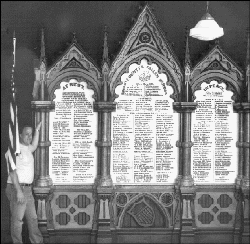
The Civil War
tablets were relocated from the second to the first floor in 1997. They can be seen
through the front windows facing Ohio Avenue, this floor is now home to the Veterans
Services Commission. The photo above features former Shelby County Historical Society Trustee Tom Homan and was taken by Larry
Roettger prior to the relocation of the tablets.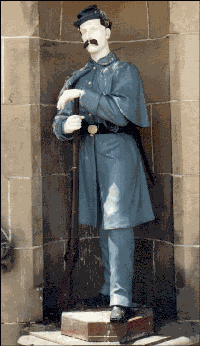
Occupancy of the structure began
immediately. The veterans continued to lobby for the last, fitting touch to the building.
By a resolution passed on November 1, 1897, the old warriors asked for the "placing
in the front a statue of a soldier, as originally intended, "as a lesson to
perpetuate memories of valor and sacrifice and to "inculcate lessons of patriotism in
the present and coming generations."
In December of 1900, the edifice was finally
completed when 'Sgt. Baker' (shown at right) was hoisted into place, 83 feet above Ohio
Avenue. A worker sandblasting the building in 1960 was reported as saying that Sgt. Baker
was so real, "I thought he ought to say something to me."
Although the finishing touch was not added until
1900, the building was put to a multitude of uses immediately. A bookstore and picture
framing business opened on September 1st, 1876, in the southeast corner of the first
floor. Government offices for both the village of Sidney and Clinton Township were moved
to the second floor. The third floor housed the opera hall.
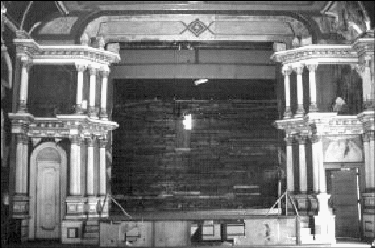
The third floor of the Monumental Building, looking east towards the
‘Opera House’ stage.
Photo taken by Sherrie Casad-Lodge in 1997.
Large enough to seat several hundred people, the third floor quickly became the center
of social and cultural life in Sidney. The most famous vaudeville acts from around the
country performed on its stage for nearly two decades. William F. Cody, better known as
'Buffalo Bill' appeared here in 1881 along with Flying Cloud, 'the oldest war chief of the
Sioux nation,' and many others. A giant elephant show featuring "Giant men, giant
women, and giant animals from all corners of the globe" packed the opera house in
June, 1882. Adults paid 25 cents and children 10 cents for these spectacles. There were
many others. By the late 1890’s, the use of the third floor for public performances
had been discontinued due to building code problems. The area was then used by the
Independent Order of Odd Fellows, a local fraternal organization, for a number of years.
A fascinating, but controversial, period in the history of the building began in 1879
when the library trustees accepted a proposal from the Monumental Building trustees to
move to that location. However, the fine print of the agreement permitted the building
trustees to open the library "...as soon as the funds at their command will justify
them in doing so." After the move was completed, the building trustees refused to
open the library, citing financial problems.
The library reopened in 1886 under the guidance of the Hon. William Wyman, who had just
retired as Probate Judge. The building trustees wished to expand the library in June,
1898. At that point, the library association still used only the east portion of the
second floor. The rest was occupied by the Neal Post of the G.A.R., a group of civil war
veterans, equivalent to the American Legion of today. The expansion plans were unveiled
for the men and they were asked to vacate the second floor. The vets refused, and the
battle was on.
The soldiers retained attorney
David Oldham and the building trustees hired cagey, court room veteran S.L. Wicoff. The
legal and emotional fireworks lasted almost four years. Many of the war heroes testified
at the trial, pleading that the Monumental Building was built in honor of their comrades,
and with funds the soldiers helped raise. Evict the veterans from their own building? The
mere thought was preposterous! To make matters worse, the court fight pitted the veterans
against the trustees of the building, all of whom were also veterans. The trustees pointed
to the original building plans, prepared by architect Samuel Lane, which clearly showed
the second floor as being reserved for a library. The judge ruled in favor of the
trustees. The soldiers appealed and the legal wrangling continued...all the way to the
Ohio Supreme Court. In the end, the trustees prevailed, and the Civil War veterans left
their building in 1902. In the years that followed, the library grew steadily and was
expanded in 1928 to a portion of the first floor of the building.
Numerous other
businesses and agencies once called the building home. A grocery occupied the front corner
of the first floor. The location was also occupied by a shoe repair business, an express
delivery company, and the Western Ohio
Electric Railway, which used it as a ticket office and depot.
Besides the Odd Fellows, the structure served as home for many charitable groups, such
as IUTIS, the Sidney Wheel Club, the Veterans of Foreign Wars, Sweet Adelines, Charity
League and S&B Community Theatre. The Post Office, Bureau of Employment Services, and
other government agencies also used the building. Over the years, the growth of the city,
and consequently government operations, necessitated changes. 1941 saw the first
significant exodus from the Monumental Building as the city offices were moved from the
second floor to the recently completed city building. The city's fire department, which
had occupied the first floor for sixty years, also sadly moved out. The Shelby County
Civil Defense moved into the first floor, but subsequently moved to new quarters in the
1970's. By the 1950's, further growth also compelled the trustees of the library to seek a
new home. In 1959, the library left its
home of eighty years and moved to its present location on North Street. The second floor
was used as a teen center for a few years, but, too soon, it was vacant again. The
majestic building appeared doomed.
In 1993, thanks to the leadership of then City Manager Bill Barlow, and the help of
community development block grant funds ($300,000), major repairs to the exterior and the
roof were completed. The Veteran's Service Office then refurbished and occupy the first
floor. Finally, the grand old structure is making a comeback. In an August, 1995, article
in Ohio Magazine, author John Fleischman traced the construction of fourteen
monumental buildings in Ohio between 1876 and 1925. Twelve now survive. Fleischman
commented that our building "...is renowned as Ohio's first veterans' hall..."
and is a "…Gothic Revival masterpiece." Striking a somber tone, the author
concluded: "Six or so major American wars later, Ohio's surviving veterans'
memorial halls march toward the new century in ragged order. Some halls are all spit and
polish; others hang by a thread. As a sacred pledge to the honored dead, they represent a
standing reproach to the forgetful living." We have a sacred trust to ensure that
this, our most hallowed and historically significant building, is properly preserved. It
would be thoughtless to let the passage of time lessen the value of the sacrifices of the
men whose names are enshrined on the tablets.
[ Back to Civil War Index ] |

